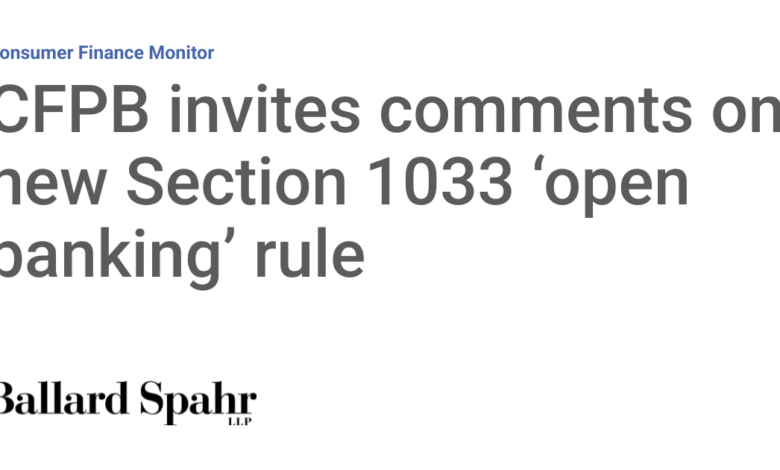New Open Banking Rule Shocks! CFPB Wants YOUR Opinion Now!

CFPB Invites Public Comments on the New Section 1033 ‘Open Banking’ Rule
The Consumer Financial Protection Bureau (CFPB) has recently sought input from the public on a significant policy initiative known as the Section 1033 rule regarding open banking. This proposed rule plays a crucial role in shaping the future of consumer access to financial data and aims to empower consumers by enhancing their knowledge and control over their personal financial information. Open banking is a system that allows third-party financial service providers to access consumer banking data, usually through application programming interfaces (APIs), enabling them to offer tailored services and innovative solutions. In this blog, we will dissect the major components of this proposed rule, its implications, and the context within the broader financial landscape.
Understanding Open Banking
Open banking refers to the practice whereby banks and financial institutions allow third-party developers to access consumer data via secure APIs. This access typically includes account balances, transaction history, and other relevant financial data. This initiative is intended to foster innovation within the financial sector, helping to create a competitive marketplace where consumers can select from various service providers. It is also seen as a way to improve customer experiences by providing personalized products and services.
The concept of open banking isn’t just rooted in convenience; it aims to give consumers greater control over their financial information. By allowing third-party providers to develop applications that can analyze or manipulate this data, the overall goal is to offer a broader spectrum of financial solutions tailored to the unique needs of individual users.
The Proposed Section 1033 Rule
The demand for more transparency and control in accessing consumer financial data has led the CFPB to undertake the development of regulations under Section 1033 of the Dodd-Frank Act. This proposed rule seeks to achieve two primary objectives:
- Deliver Transparency: Consumers should know what financial data is collected, how it is shared, and with whom.
- Enhance Control: Individuals should have the power to choose which third parties access their financial information, or even to deny access altogether.
The CFPB aims to establish regulations that clarify consumer rights while ensuring that financial institutions prioritize safeguarding personal data. These rulemaking efforts will take into account both the consumer’s desire for enhanced services and the financial industry’s concerns regarding data security and potential misuse.
Key Components of the Proposed Rule
1. Consumer Consent
Central to the proposed Section 1033 rule is the requirement for explicit consent from consumers before their data can be accessed by third-party providers. This measure aims to ensure that consumers fully understand, not only who can access their data, but also the scope and limits of that access.
2. Clear and Concise Data Sharing Policies
The rule emphasizes the need for financial institutions to provide clear, understandable policies surrounding data sharing. Consumers should be able to easily navigate these policies, allowing them to make informed decisions regarding their data.
3. Facilitating Enhanced Competition
By empowering consumers with their data, the proposed rule aims to enhance competition in the financial services sector. When consumers can share their financial data with a range of providers, it potentially levels the playing field, allowing smaller or newer firms to offer innovative products and services that may better meet consumer needs.
4. Security Measures
Given the sensitive nature of financial data, the proposed rule also focuses on implementing robust security measures to protect consumer information. It asks financial institutions to disclose how data will be safeguarded and what steps are being taken to prevent breaches or unauthorized access.
5. Access to Financial Records
Under this rule, consumers will have the right to retrieve their financial records from financial institutions in an efficient manner. This ensures ease of access when consumers need their records to make financial decisions or take advantage of third-party services.
Why Public Comments Matter
The CFPB recognizes that stakeholder input is invaluable in creating a rule that is not only effective but also fair. By inviting public comments, the Bureau aims to solicit diverse perspectives, which may include:
- Consumer Advocates: Organizations that represent consumer rights can provide insights into how the proposed rule may affect everyday users.
- Financial Institutions: Banks and other financial entities can share their concerns about privacy, security, and potential compliance burdens.
- Technology Developers: Those in the fintech space may offer ideas on how open banking can yield innovative, consumer-friendly solutions.
Public comments will allow the CFPB to understand the implications of the proposed rule in real-world contexts. Stakeholder engagement fosters a balanced approach that carefully weighs the benefits of innovation against the necessity of consumer protection.
Potential Challenges
While the proposed Section 1033 rule presents exciting opportunities for consumers and the financial industry alike, several challenges could arise:
1. Data Security Concerns
One pressing challenge revolves around the security of consumer data. With increased access, the risk of data breaches may escalate. Financial institutions must ensure that their systems are fortified against potential threats.
2. Consumer Understanding
Another potential hurdle is ensuring that consumers adequately understand their rights and the implications of granting access to their financial information. There may be a need for extensive education and outreach to ensure consumers make informed choices.
3. Compliance for Financial Institutions
Compliance with newly established rules may present operational challenges for banks and financial institutions. They may need to invest in technology and resources to meet requirements stipulated in the rule.
Looking Ahead
As the CFPB proceeds with gathering comments and refining the Section 1033 rule, it remains essential to maintain a consumer-centric approach. Empowering consumers with their own financial data has the potential to accelerate innovation in financial services, enhance competition, and ultimately benefit consumers.
In this evolving landscape, stakeholders from various sectors must collaborate to address the challenges associated with open banking. Striking a careful balance between encouraging commercial innovation and ensuring consumer protection will be key.
In conclusion, the CFPB’s effort to invite public comments on the Section 1033 rule signifies a pivotal movement towards a more transparent and consumer-empowered financial ecosystem. This initiative has the potential to reshape how consumers interact with their financial data and the services offered to them.
Summary
- The CFPB is seeking public input on the proposed Section 1033 rule related to open banking.
- Open banking aims to empower consumers by allowing them control over their banking data.
- Key components of the proposed rule include consumer consent, clear data-sharing policies, enhanced competition, security measures, and easy access to financial records.
- Public comments are essential for gathering diverse perspectives and ensuring the rule is effective and fair.
- Challenges include data security concerns, consumer understanding, and compliance burdens for financial institutions.
- The initiative represents a significant step toward creating a more transparent and consumer-driven financial ecosystem.





